Development of Social Intensity Database Using Asian International Input–Output Table for Social Life Cycle Assessment
Abstract
:1. Introduction
2. Materials and Methods
2.1. Social Footprint Indicators
2.1.1. Total Employment
2.1.2. Paid Worker
2.1.3. Vulnerable Employment
2.1.4. Wages
2.1.5. Fatal Occupational Injury
2.1.6. Non-Fatal Occupational Injuries
2.2. Input–Output Model
2.3. Data Sources and Data Processing
3. Results
3.1. Total Employment
3.1.1. Total Employment Intensity
3.1.2. Employment Footprint per Capita
3.2. Paid Worker
3.2.1. Paid Worker Intensity
3.2.2. Paid Worker Footprint per Capita
3.3. Vulnerable Employment
3.3.1. Vulnerable Employment Intensity
3.3.2. Vulnerable Employment Footprint per Capita
3.4. Wages
3.4.1. Wages Intensity
3.4.2. Wages Footprint per Capita
3.5. Non-Fatal Occupational Injury
3.5.1. Non-Fatal Occupational Injury Intensity
3.5.2. Non-Fatal Occupational Injuries Footprint per Capita
3.6. Fatal Occupational Injury
3.6.1. Fatal Occupational Injury Intensity
3.6.2. Fatal Occupational Injury Footprint per Capita
4. Discussion
4.1. Policy Implications
4.2. Uncertainties and Limitations
5. Conclusions
Acknowledgments
Author Contributions
Conflicts of Interest
Appendix A
| IO Code | Economic Sector |
|---|---|
| Primary sector | |
| 1 | Paddy |
| 2 | Other grain |
| 3 | Food crops |
| 4 | Non-food crops |
| 5 | Livestock and poultry |
| 6 | Forestry |
| 7 | Fishery |
| 8 | Crude petroleum and natural gas |
| 9 | Iron ore |
| 10 | Other metallic ore |
| 11 | Non-metallic ore and quarrying |
| Secondary sector | |
| 12 | Milled grain and flour |
| 13 | Fish products |
| 14 | Slaughtering, meat products and dairy products |
| 15 | Other food products |
| 16 | Beverage |
| 17 | Tobacco |
| 18 | Spinning |
| 19 | Weaving and dyeing |
| 20 | Knitting |
| 21 | Wearing apparel |
| 22 | Other made-up textile products |
| 23 | Leather and leather products |
| 24 | Timber |
| 25 | Wooden furniture |
| 26 | Other wooden products |
| 27 | Pulp and paper |
| 28 | Printing and publishing |
| 29 | Synthetic resins and fiber |
| 30 | Basic industrial chemicals |
| 31 | Chemical fertilizers and pesticides |
| 32 | Drugs and medicine |
| 33 | Other chemical products |
| 34 | Refined petroleum and its products |
| 35 | Plastic products |
| 36 | Tires and tubes |
| 37 | Other rubber products |
| 38 | Cement and cement products |
| 39 | Glass and glass products |
| 40 | Other non-metallic mineral products |
| 41 | Iron and steel |
| 42 | Non-ferrous metal |
| 43 | Metal products |
| 44 | Boilers, Engines and turbines |
| 45 | General machinery |
| 46 | Metal working machinery |
| 47 | Specialized machinery |
| 48 | Heavy Electrical equipment |
| 49 | Television sets, radios, audios and communication equipment |
| 50 | Electronic computing equipment |
| 51 | Semiconductors and integrated circuits |
| 52 | Other electronics and electronic products |
| 53 | Household electrical equipment |
| 54 | Lighting fixtures, batteries, wiring and others |
| 55 | Motor vehicles |
| 56 | Motor cycles |
| 57 | Shipbuilding |
| 58 | Other transport equipment |
| 59 | Precision machines |
| 60 | Other manufacturing products |
| 61 | Electricity and gas |
| 62 | Water supply |
| 63 | Building construction |
| 64 | Other construction |
| Tertiary sector | |
| 65 | Wholesale and retail trade |
| 66 | Transportation |
| 67 | Telephone and telecommunication |
| 68 | Finance and insurance |
| 69 | Real estate |
| 70 | Education and research |
| 71 | Medical and health service |
| 72 | Restaurants |
| 73 | Hotel |
| 74 | Other services |
| 75 | Public administration |
| 76 | Unclassified |
References
- International Organization for Standardization (ISO). ISO 14040: Environmental Management—Life Cycle Assessment—Principals and Framework; ISO: Geneva, Switzerland, 2006. [Google Scholar]
- United Nations Environment Programme (UNEP). Guidelines for Social Life Cycle Assessment of Products; UNEP: Gent, Belgium, 2009; Available online: http://www.unep.fr/shared/publications/pdf/DTIx1164xPA-guidelines_sLCA.pdf (accessed on 1 May 2015).
- Dreyer, L.C. Inclusion of Social Aspects in Life Cycle Assessment of Products-Development of a Methodology for Social Life Cycle Assessment. Ph.D. Thesis, Technical University of Denmark, Kongens Lyngby, Denmark, April 2009. [Google Scholar]
- Hutchins, M.J.; Robinson, S.L.; Dornfeld, D. Understanding Life Cycle Social Impacts in Manufacturing: A Processed-Based Approach. J. Manuf. Syst. 2013, 32, 536–542. [Google Scholar] [CrossRef]
- Benoit-Norris, C.; Cavan, D.A.; Norris, G. Identifying Social Impacts in Product Supply Chains: Overview and Application of the Social Hotspot Database. Sustainability 2012, 4, 1946–1965. [Google Scholar] [CrossRef]
- Garrett-Peltier, H. The Employment Impacts of Economy-Wide Investments in Renewable Energy and Energy Efficiency. Ph.D. Thesis, University of Massachusetts Amherst, Amherst, MA, USA, September 2010. [Google Scholar]
- Martínez, S.H.; van Eijck, J.; da Cunha, M.P.; Guilhoto, J.; Walter, A.; Faaij, A. Analysis of Socio-Economic Impacts of Sustainable Sugarcane–Ethanol Production by Means of Inter-Regional Input–Output Analysis: Demonstrated for Northeast Brazil. Renew. Sustain. Energy Rev. 2013, 28, 290–316. [Google Scholar] [CrossRef]
- Chen, T.P.; Chang, T.; Chiau, W.; Shih, Y. Social Economic Assessment of Coastal Area Industrial Development: An Application of Input-Output Model to Oyster Farming in Taiwan. Ocean Coast. Manag. 2013, 73, 153–159. [Google Scholar] [CrossRef]
- Tang, X.; Zhang, B.; Wei, X. Employment Impacts of Petroleum Industry in China: An Input-Output Analysis. Int. J. Glob. Energ. Issues 2013, 36, 116–129. [Google Scholar] [CrossRef]
- Lee, M.K.; Yoo, S.H. The Role of the Capture Fisheries and Aquaculture Sectors in the Korean National Economy: An Input–Output Analysis. Mar. Policy 2014, 44, 448–456. [Google Scholar] [CrossRef]
- Ferrão, P.; Ribeiro, P.; Rodrigues, J.; Marquesa, A.; Preto, M.; Amaral, M.; Domingosa, T.; Lopes, A.; Costa, I. Environmental, Economic and Social Costs and Benefits of a Packaging Waste Management System: A Portuguese Case Study. Resour. Conserv. Recycl. 2014, 85, 67–78. [Google Scholar] [CrossRef]
- McBain, D.; Alsamawi, A. Quantitative Accounting for Social Economic Indicators. Natural Resour. Forum 2014, 38, 193–202. [Google Scholar] [CrossRef]
- Malik, A.; Lenzen, M.; Geschke, A. Triple Bottom Line Study of a Lignocellulosic Biofuel Industry. GCB Bioenergy 2015, 8, 96–110. [Google Scholar] [CrossRef]
- Yang, Y.; Zhang, B.; Cheng, J.; Pu, S. Socio-Economic Impacts of Algae-Derived Biodiesel Industrial Development in China: An Input–Output Analysis. Algal Res. 2015, 9, 74–81. [Google Scholar] [CrossRef]
- Kucukvar, M.; Egilmez, G.; Tatari, O. Sustainability Assessment of U.S. Final Consumption and Investments: Triple-Bottom-Line Input–Output Analysis. J. Clean. Prod. 2014, 81, 234–243. [Google Scholar] [CrossRef]
- Alsamawi, A.; Murray, J.; Lenzen, M. The Employment Footprints of Nations. J. Ind. Ecol. 2014, 18, 59–70. [Google Scholar] [CrossRef]
- Chang, Y.; Ries, R.J.; Wang, Y. The Quantification of the Embodied Impacts of Construction Projects on Energy, Environment, and Society Based on I–O Lca. Energy Policy 2011, 39, 6321–6330. [Google Scholar] [CrossRef]
- Onat, N.C.; Kucukvar, M.; Tatari, O. Integrating Triple Bottom Line Input-Output Analysis into Life Cycle Sustainability Assessment Framework: The Case for Us Buildings. Int. J. Life Cycle Assess. 2014, 19, 1488–1505. [Google Scholar] [CrossRef]
- Simas, M.S.; Golsteijn, L.; Huijbregts, M.A.J.; Wood, R.; Hertwich, E.G. The “Bad Labor” Footprint: Quantifying the Social Impacts of Globalization. Sustainability 2014, 6, 7514–7540. [Google Scholar] [CrossRef]
- Gómez-Paredes, J.; Yamasue, E.; Okumura, H.; Ishihara, K.N. The Labour Footprint: A Framework to Assess Labour in a Complex Economy. Econ. Syst. Res. 2015, 27, 1–25. [Google Scholar] [CrossRef]
- Papong, S.; Itsubo, N.; Malakul, P.; Shukuya, M. Development of the Social Inventory Database in Thailand Using Input–Output Analysis. Sustainability 2015, 7, 7684–7713. [Google Scholar] [CrossRef]
- International Labour Organization (ILO). Employment Definition; ILO: Geneva, Switzerland, 2015; Available online: http://laborsta.ilo.org/definition_E.html (accessed on 1 February 2016).
- International Labour Organization’s (ILO). Guide to the New Millennium Development Goals Employment Indicators; ILO: Geneva, Switzerland, 2009; Available online: http://www.ilo.org/public/english/employment/download/mdg_en.pdf (accessed on 1 February 2016).
- International Labour Organization (ILO). Global Employment Trends 2014: Risk of a Jobless Recovery? ILO: Geneva, Switzerland, 2014. [Google Scholar]
- Leontief, W.W. Input–Output Economics, 2nd ed.; Oxford University Press: New York, NY, USA, 1986. [Google Scholar]
- Miller, R.E.; Blair, P.D. Input–Output Analysis: Foundations and Extensions; Cambridge University Press: New York, NY, USA, 2009. [Google Scholar]
- Institute of Developing Economies, Japan External Trade Organization (IDE-JETRO). Asian International Input-Output Table 2005–Employment Matrix; IDE Statistical Data Series No. 98; IDE-JETRO: Tokyo, Japan, 2013.
- Institute of Developing Economies, Japan External Trade Organization (IDE-JETRO). Asian International Input-Output Table 2005–Excel Table; IDE-JETRO: Tokyo, Japan, 2013. Available online: http://www.ide.go.jp/English/Data/Io/ (accessed on 1 December 2014).
- U.S. Bureau of Labor Statistics. Occupational Injuries and Illnesses: Counts, Rates, and Characteristics, 2005; U.S. Department of Labor: Washington, DC, USA, 2007. Available online: http://www.bls.gov/iif/oshbulletin2005.htm (accessed on 1 October 2015).
- U.S. Bureau of Labor Statistics. Fatal Occupational Injuries to Private Sector Wage and Salary Workers, Government Workers, and Self-Employed Workers by Industry, All United States, 2005; U.S. Department of Labor: Washington, DC, USA, 2007. Available online: http://www.bls.gov/iif/oshwc/cfoi/cftb0207.pdf (accessed on 1 October 2015).
- International Labour Organization (ILO). Occupational Injuries (Selected Countries for Japan, Taiwan and South Korea); ILO: Geneva, Switzerland, 2014; Available online: http://laborsta.ilo.org/ (accessed on 1 October 2015).
- Thailand’s Social Security Office (SSO). Occupational Accidents and Fatality Cases; Ministry of Labour: Bangkok, Thailand, 2006.
- Korea Ministry of Employment and Labor (KMOEL). Summary of Occupational Accidents by Industry (Divisions) in 2005; KMOEL: Sejong, South Korea, 2014. Available online: http://kosis.kr/eng/ (accessed on 1 November 2015).
- Singapore Ministry of Manpower. Workplace Injuries and Occupational Diseases 2006; Singapore Ministry of Manpower: Singapore, 2015. Available online: http://www.mom.gov.sg/workplace-safety-and-health/wsh-reports-and-statistics (accessed on 1 November 2015).
- Abas, A.L.; Said, R.B.M.; Mohammed, M.A.B.A.; Sathiakumar, N. Fatal Occupational Injuries among Non-governmental Employees in Malaysia. Int. J. Occup. Environ. Health. 2013, 56, 65–76. [Google Scholar] [CrossRef] [PubMed]
- Abas, A.L.; Said, R.B.M.; Mohammed, M.A.B.A.; Sathiakumar, N. Non-fatal Occupational Injuries among Non-governmental Employees in Malaysia. Int. J. Occup. Environ. Health. 2011, 17, 38–48. [Google Scholar] [CrossRef] [PubMed]
- Philippine Statistics Authority. Incidence Rates of Cases of Occupational Injuries with Lost Workdays by Major and Minor Industry Group and Incapacity for Work, Philippines: 2003–2007; Philippine Statistics Authority: Manila, Philippines, 2015. Available online: http://labstat.psa.gov.ph/ (accessed on 1 November 2015).
- International Labour Organization (ILO). National Profile Report on Occupational Safety and Health in China; ILO Office for China and Mongolia: Beijing, China, 2012. [Google Scholar]
- National Bureau of Statistics of China. China Statistical Yearbook 2006: Basic Statistics on Social Insurance (2005); National Bureau of Statistics of China: Beijing, China, 2015. Available online: http://www.stats.gov.cn/tjsj/ndsj/2006/indexeh.htm (accessed on 1 October 2015).
- Irfani, T.H. The Prevalence of Occupational Injuries and Illnesses in ASEAN: Comparison between Indonesia and Thailand. Public Health Indonesia. 2015, 1, 19–29. [Google Scholar]
- International Labour Organization (ILO). Occupational Injuries-8a Cases of Injury with Lost Workdays, by Economic Activity in 1997 of Indonesia; ILO: Geneva, Switzerland, 2014; Available online: http://laborsta.ilo.org/STP/guest (accessed on 1 October 2015).
- National Bureau of Statistics of China. China Statistical Yearbook 2006: Average Wage of Staff and Workers by Sector in Detail (2005); National Bureau of Statistics of China: Beijing, China, 2015. Available online: http://www.stats.gov.cn/tjsj/ndsj/2006/indexeh.htm (accessed on 1 October 2015).
- Kuwamori, H.; Uchida, Y.; Tamamura, C. Compilation of the 2005 Asian International Input-Output Table. Available online: https://jgea.org/resources/download/6580.pdf (accessed on 1 October 2015).
- International Labour Organization (ILO). Wages by Economic Activity of Japan in 2005; International Labour Organization’s (ILO): Geneva, Switzerland, 2014; Available online: http://laborsta.ilo.org/STP/guest (accessed on 1 October 2015).
- Xu, M.; Williams, E.; Allenby, B. Assessing Environmental Impacts Embodied in Manufacturing and Labor Input for China–U.S. Trade. Environ. Sci. Technol. 2010, 44, 567–573. [Google Scholar] [CrossRef] [PubMed]
- U.S. Bureau of Labor Statistics. Case and Demographic Characteristics for Work-related Injuries and Illnesses Involving Days Away From Work; U.S. Department of Labor: Washington, DC, USA, 2006. Available online: http://www.bls.gov/iif/oshcdnew2006.htm#06Supplemental_Tables (accessed on 1 February 2016).
- Bacchetta, M.; Ernst, E.; Bustamante, J.P. Globalization and Informal Jobs in Developing Countries; International Labour Office (ILO) and World Trade Organization (WTO): Geneva, Switzerland, 2009. [Google Scholar]

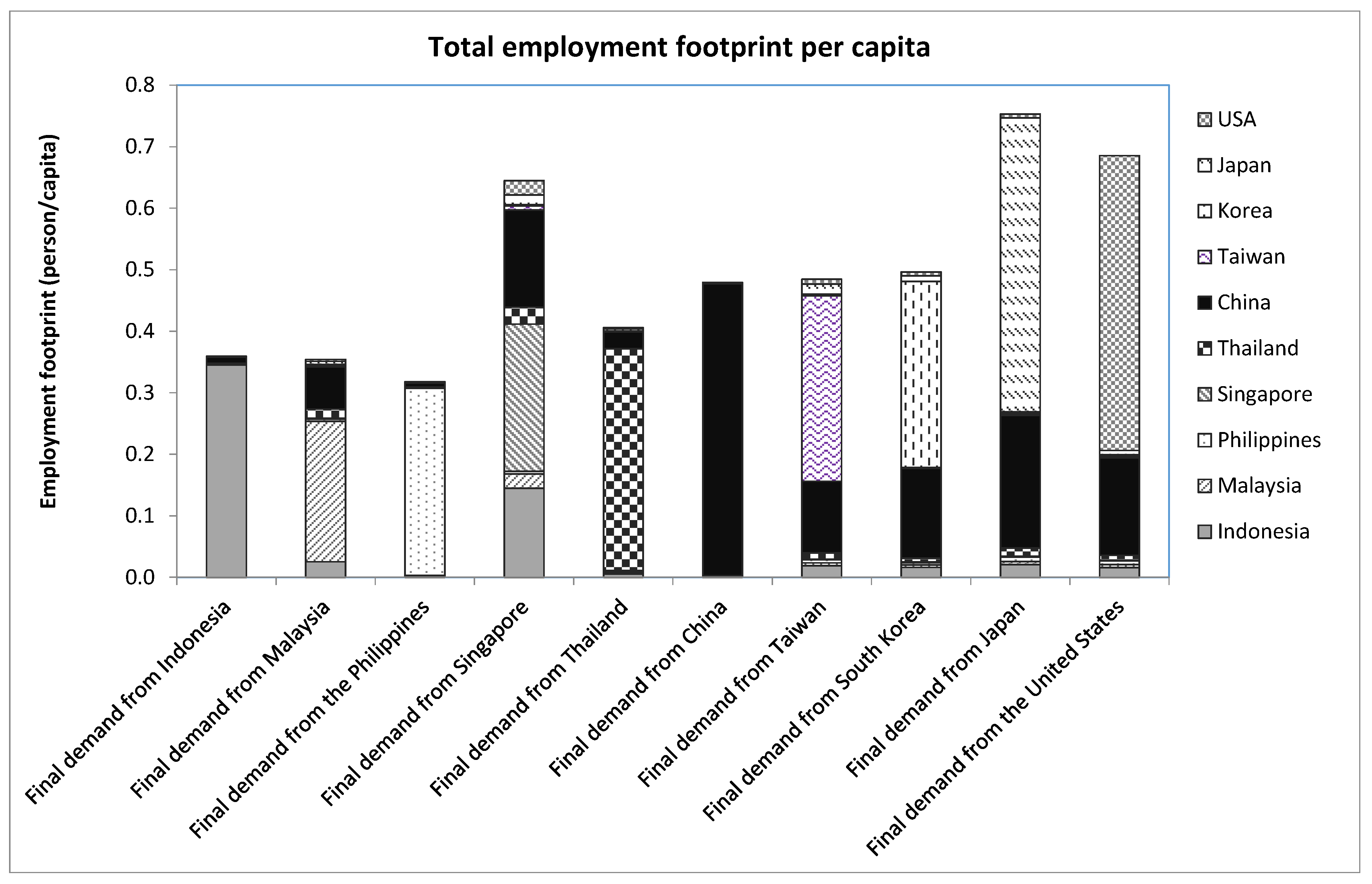

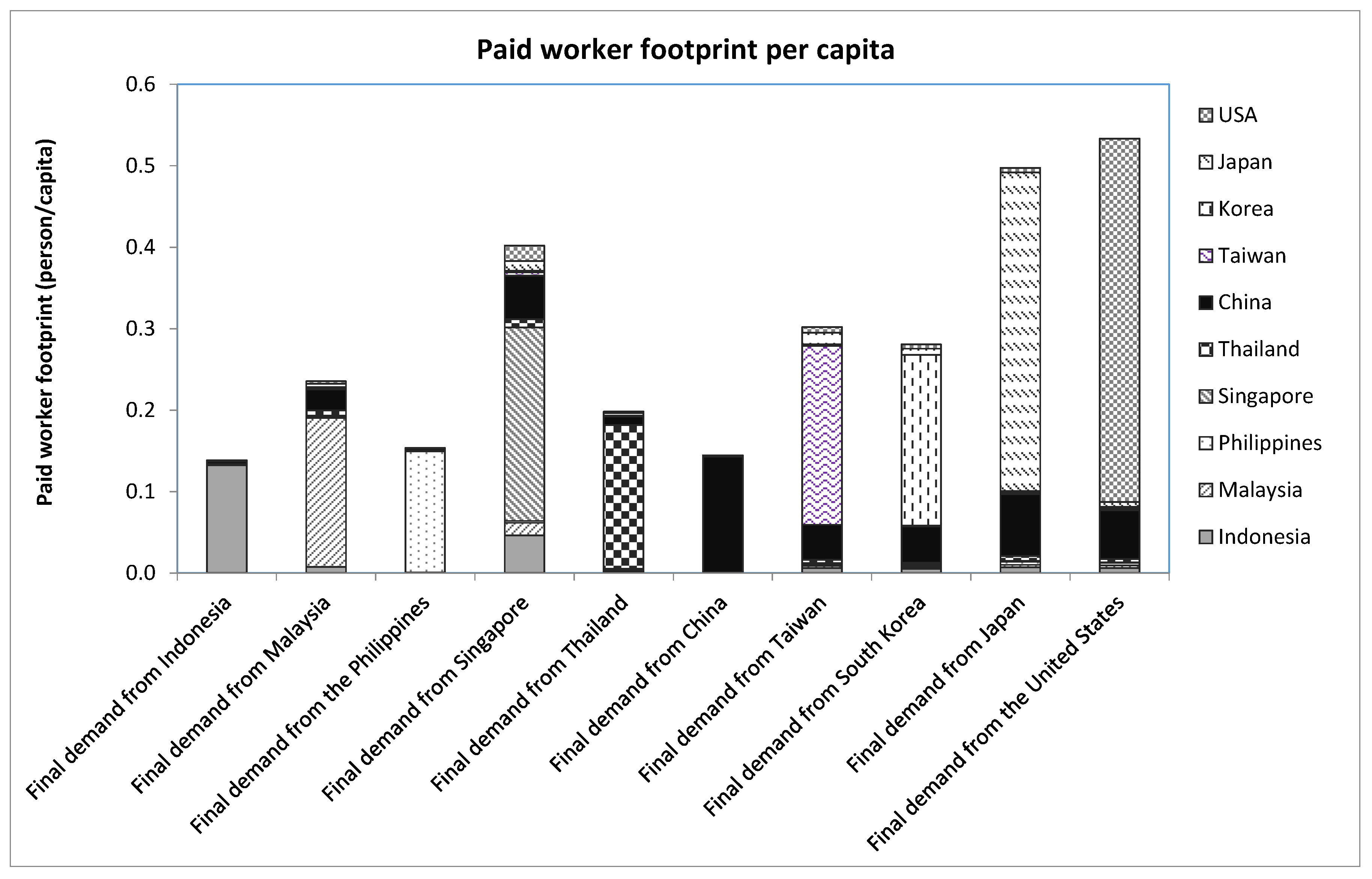
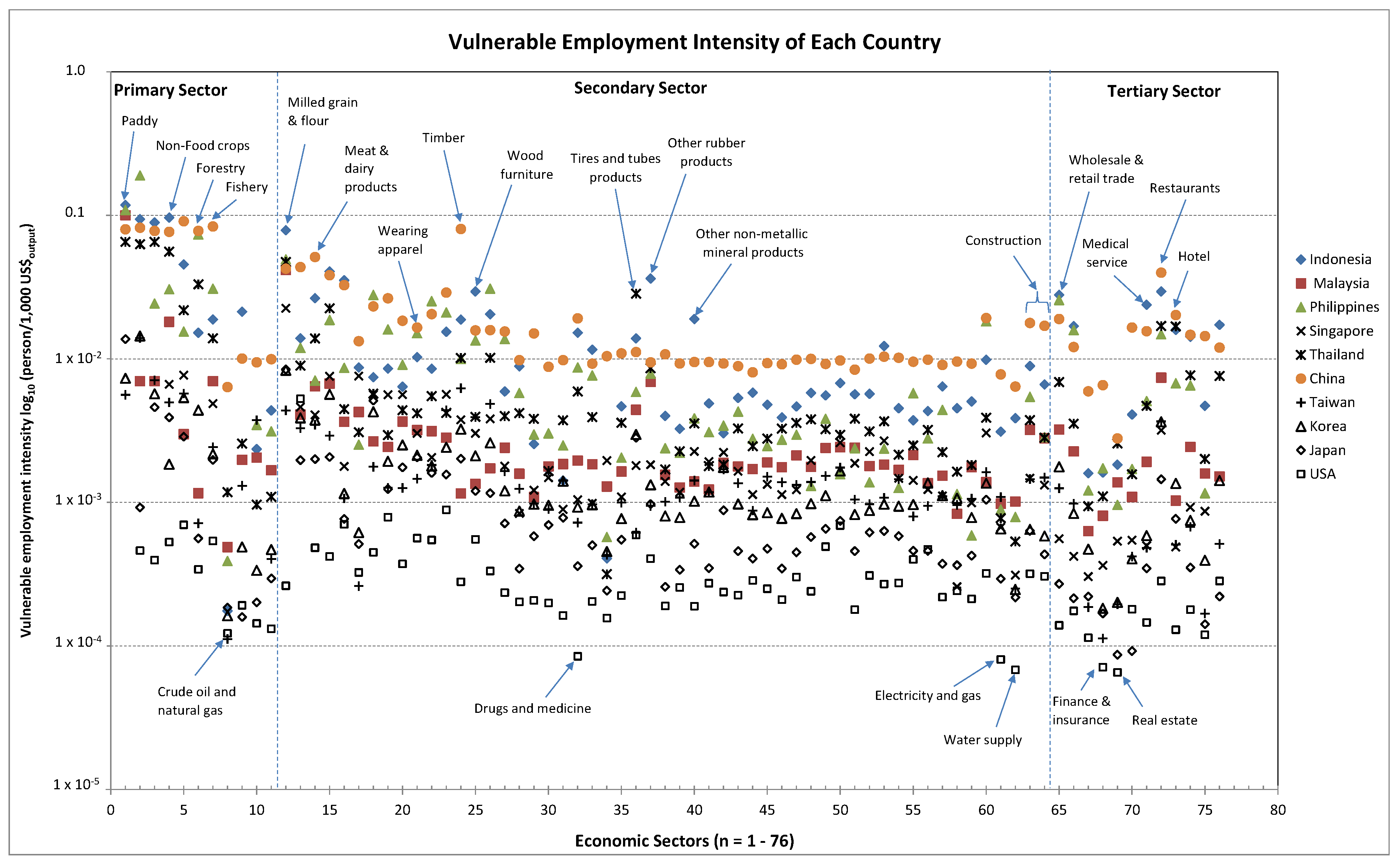

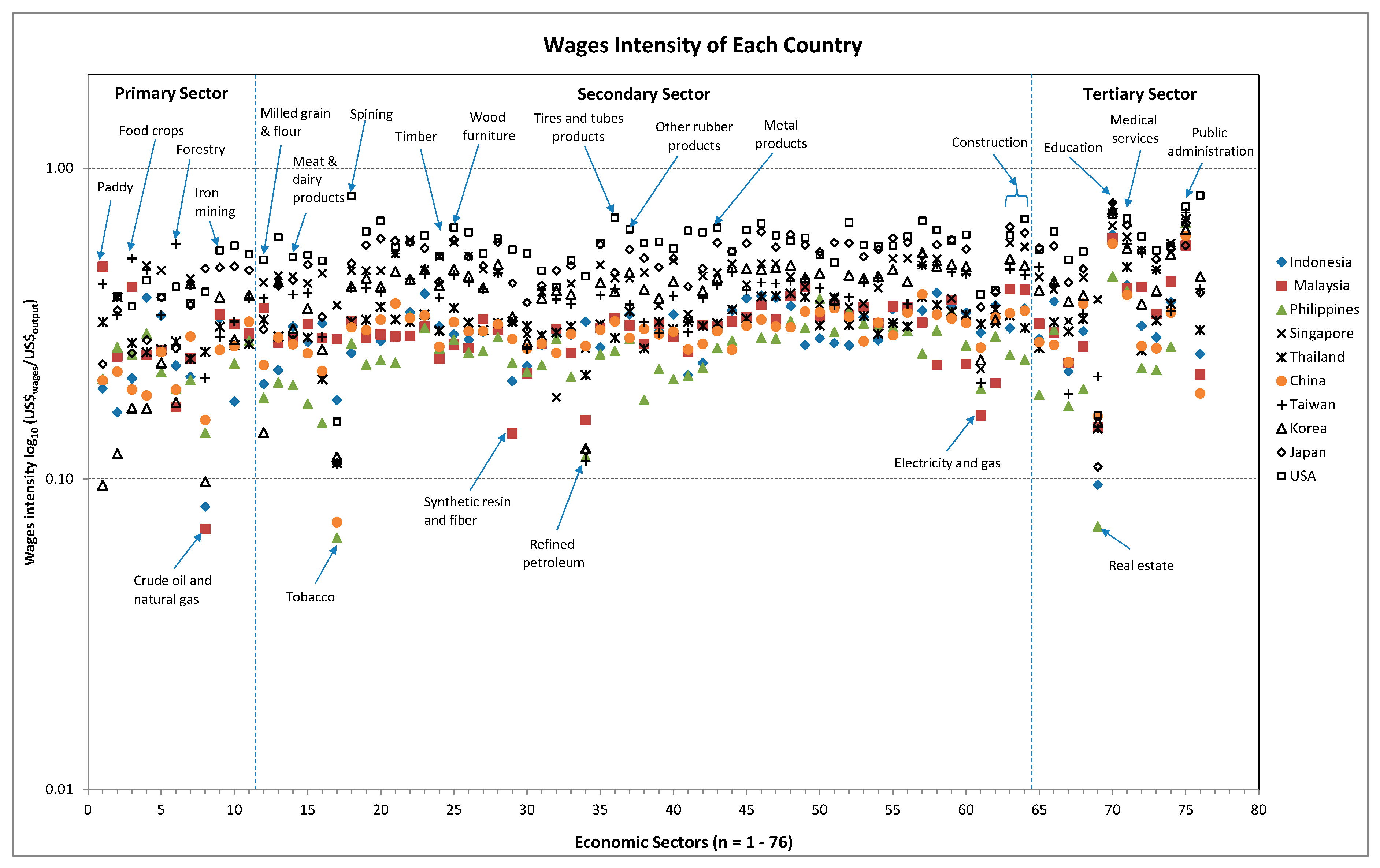
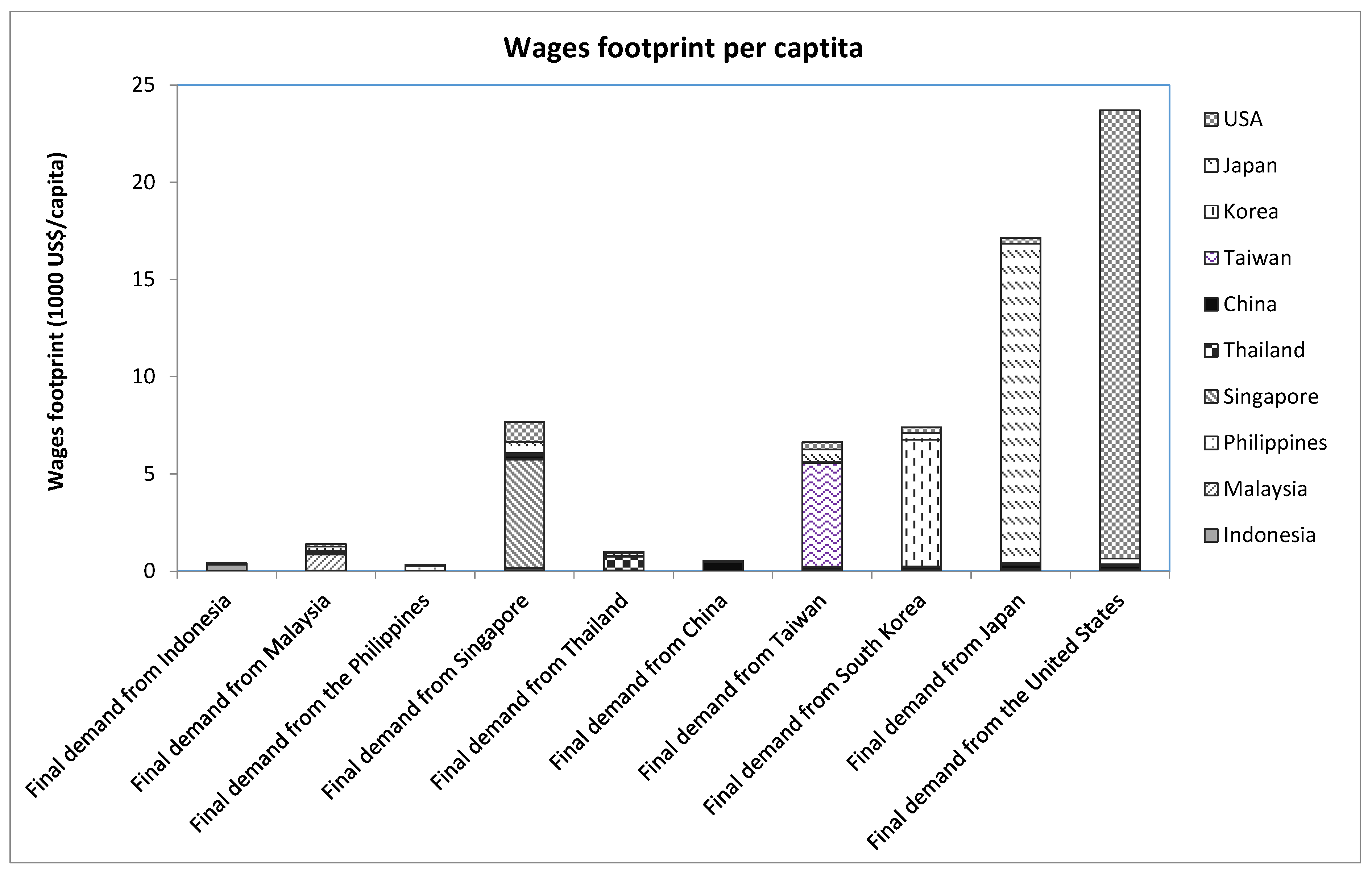

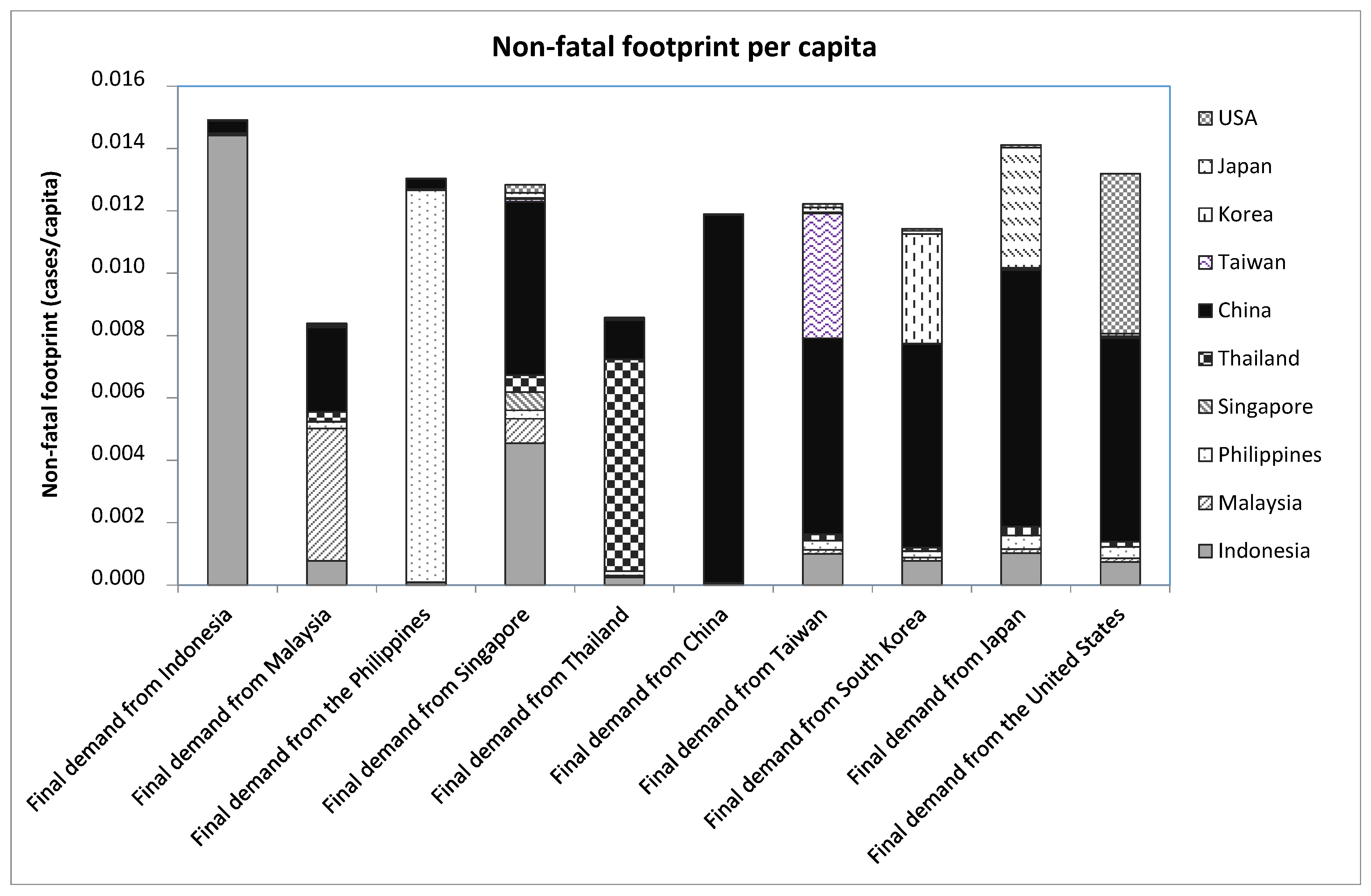
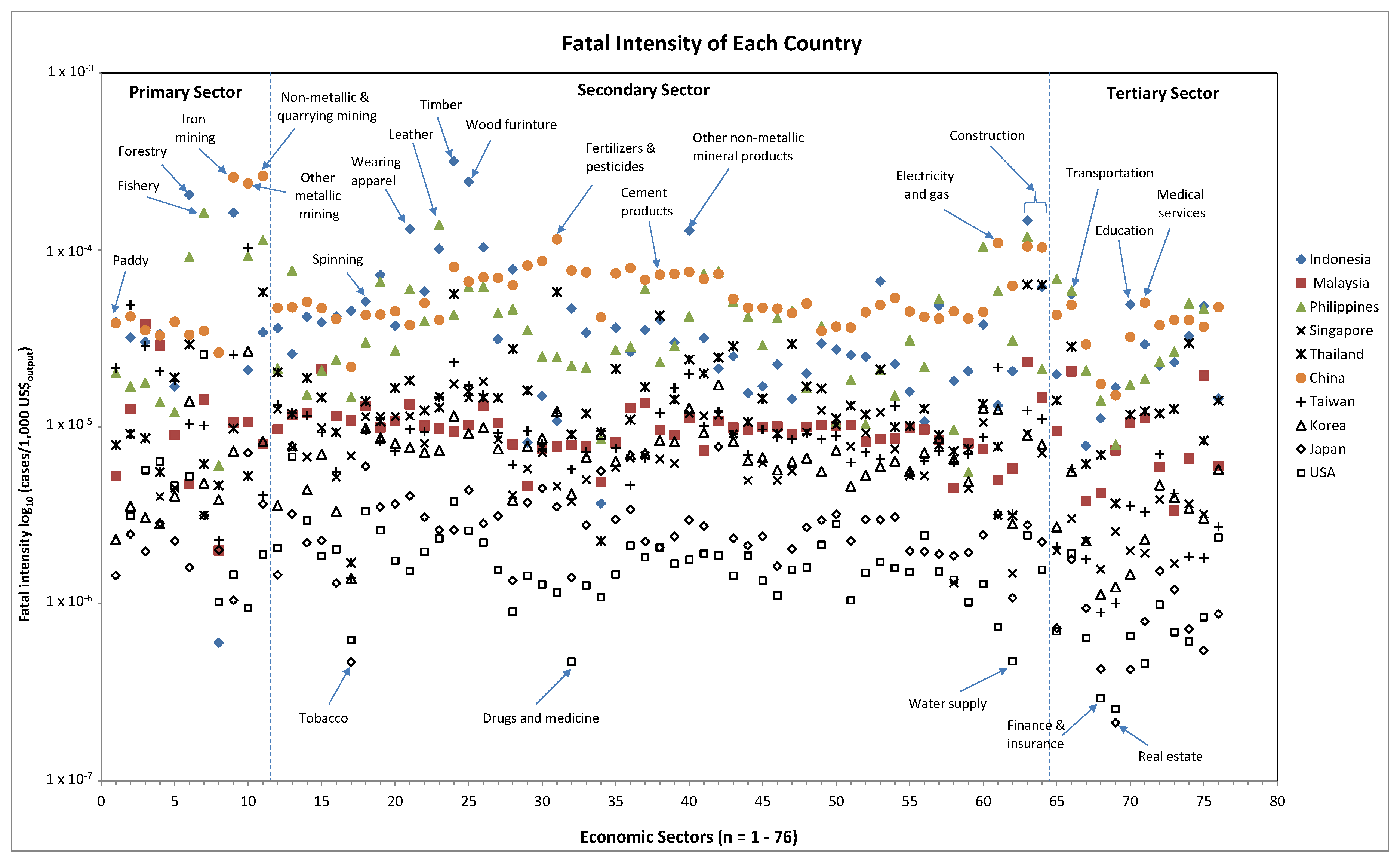
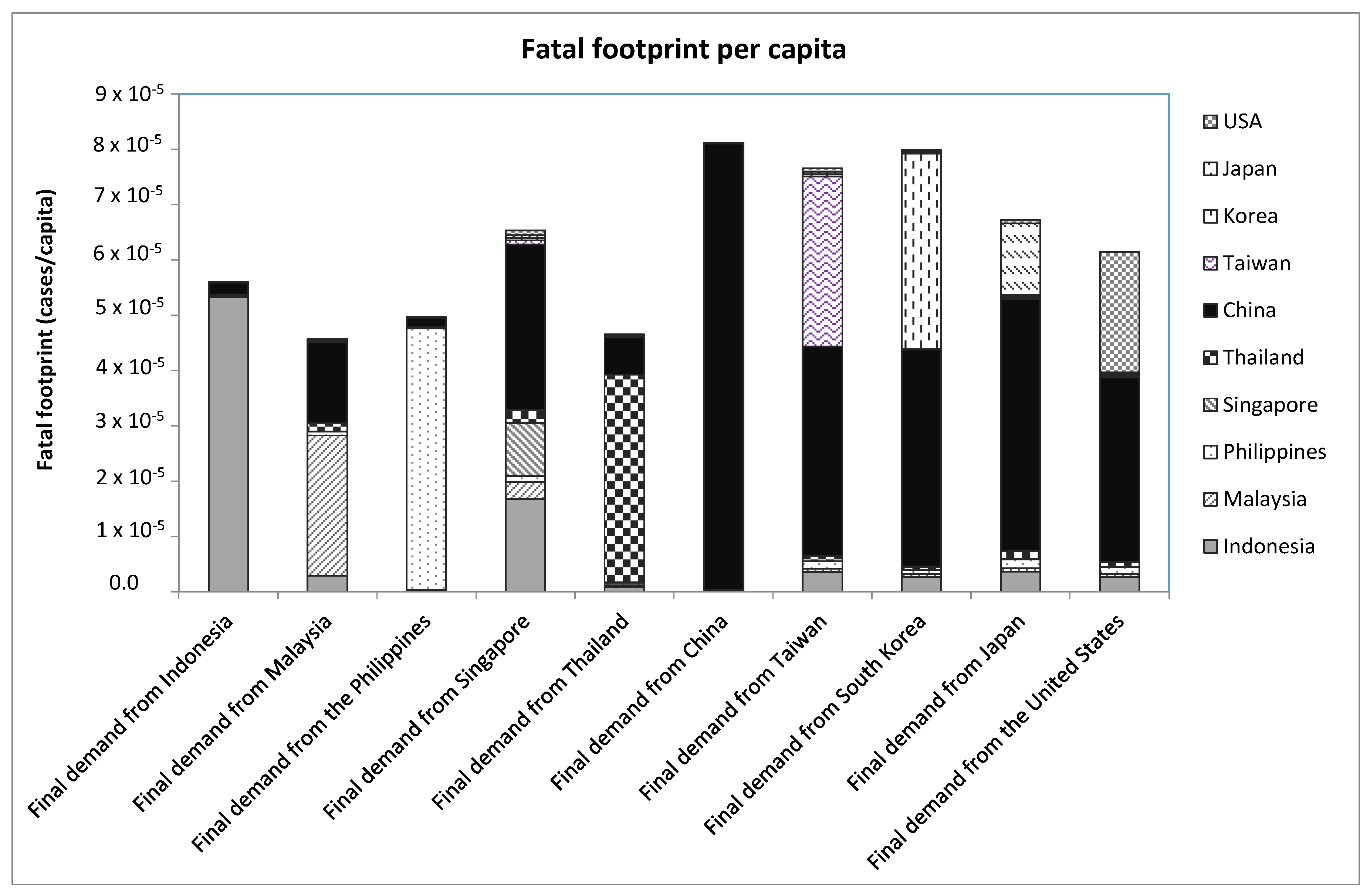
© 2016 by the authors; licensee MDPI, Basel, Switzerland. This article is an open access article distributed under the terms and conditions of the Creative Commons Attribution (CC-BY) license (http://creativecommons.org/licenses/by/4.0/).
Share and Cite
Papong, S.; Itsubo, N.; Ono, Y.; Malakul, P. Development of Social Intensity Database Using Asian International Input–Output Table for Social Life Cycle Assessment. Sustainability 2016, 8, 1135. https://doi.org/10.3390/su8111135
Papong S, Itsubo N, Ono Y, Malakul P. Development of Social Intensity Database Using Asian International Input–Output Table for Social Life Cycle Assessment. Sustainability. 2016; 8(11):1135. https://doi.org/10.3390/su8111135
Chicago/Turabian StylePapong, Seksan, Norihiro Itsubo, Yuya Ono, and Pomthong Malakul. 2016. "Development of Social Intensity Database Using Asian International Input–Output Table for Social Life Cycle Assessment" Sustainability 8, no. 11: 1135. https://doi.org/10.3390/su8111135
APA StylePapong, S., Itsubo, N., Ono, Y., & Malakul, P. (2016). Development of Social Intensity Database Using Asian International Input–Output Table for Social Life Cycle Assessment. Sustainability, 8(11), 1135. https://doi.org/10.3390/su8111135






